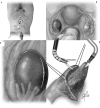Laparoendoscopic single-site surgery for management of ovarian endometriomas
- PMID: 24960481
- PMCID: PMC4035628
- DOI: 10.4293/108680813X13794522666284
Laparoendoscopic single-site surgery for management of ovarian endometriomas
Abstract
Background and objectives: To compare our initial experience in laparoscopic surgery for ovarian endometriomas performed through an umbilical incision using a single 3-channel port and flexible laparoscopic instrumentation versus traditional laparoscopy.
Methods: This study was conducted in 3 tertiary care referral centers. Since September 2009, we have performed laparoendoscopic single-site surgery in 24 patients diagnosed with ovarian endometriomas. A control group of patients with similar diagnoses who underwent traditional operative laparoscopy during the same period was included (n = 28). In the laparoendoscopic single-site surgery group, a multichannel port was inserted into the peritoneum through a 1.5- to 2.0-cm umbilical incision.
Results: Patients in the laparoendoscopic single-site surgery group were significantly older (P = .04) and had a higher body mass index (P = .005). Both groups were comparable regarding history of abdominal surgery, lateral pelvic side wall involvement, and cul-de-sac involvement. After we controlled for age and body mass index, the size of the resected endometriomas, duration of surgery, and amount of operative blood loss were comparable in both groups. When required, an additional 5-mm port was inserted in the right or left lower quadrant in the laparoendoscopic single-site surgery group to allow the use of a third instrument for additional tissue retraction or manipulation (10 of 24 patients, 41.6%). However, adhesiolysis was performed more frequently in the conventional laparoscopy group. The duration of hospital stay was <24 hours in both groups. No intraoperative complications were encountered. All incisions healed and were cosmetically satisfactory.
Conclusion: The laparoendoscopic single-site surgery technique is a reasonable initial approach for the treatment of endometriomas. In our experience, an additional side port is usually needed to treat pelvic side wall and cul-de-sac endometriosis that often accompanies endometriomas.
Figures
References
-
- Shakiba K, Bena JF, McGill KM, Minger J, Falcone T. Surgical treatment of endometriosis: a 7-year follow-up on the requirement for further surgery. Obstet Gynecol. 2008;111(6):1285–1292 - PubMed
-
- Kalogiannidis I, Lambrechts S, Amant F, Neven P, Van Gorp T, Vergote I. Laparoscopy-assisted vaginal hysterectomy compared with abdominal hysterectomy in clinical stage I endometrial cancer: safety, recurrence, and long-term outcome. Am J Obstet Gynecol. 2007;196(3):248.e1–248.e8 - PubMed
-
- Cho YH, Kim DY, Kim JH, Kim YM, Kim YT, Nam JH. Laparoscopic management of early uterine cancer: 10-year experience in Asan Medical Center. Gynecol Oncol. 2007;106(3):585–590 - PubMed
-
- Podolsky ER, Rottman SJ, Poblete H, King SA, Curcillo PG. Single port access (SPA) cholecystectomy: a completely transumbilical approach. J Laparoendosc Adv Surg Tech A. 2009;19(2):219–222 - PubMed
Publication types
MeSH terms
LinkOut - more resources
Full Text Sources
Other Literature Sources
Medical

